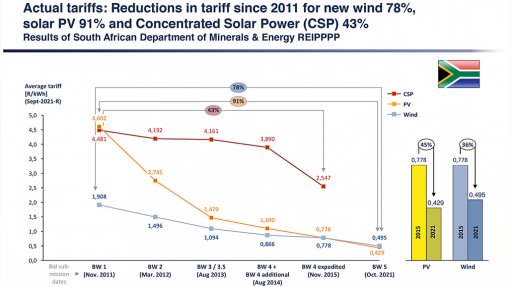
Photo by: CSIR
The Council for Scientific and Industrial Research (CSIR) says the tariffs achieved during the fifth bid window of the Renewable Energy Independent Power Producer Procurement Programme (REIPPPP) confirm its previous analysis showing that renewable energy is the lowest cost generation option available for South Africa.
In late October, Mineral Resources and Energy Minister Gwede Mantashe announced the names of 25 preferred bidders to build 13 wind and 12 solar projects with a combined capacity of 2 583 MW.
The weighted average price across the projects came in at an impressive 47.3c/kWh, the lowest yet to be achieved in South Africa. The cheapest wind project was bid at 34.4c/kWh, while the cheapest solar PV project came in at 37.4c/kWh.
The CSIR shows that the actual tariffs achieved under the REIPPPP since 2011 have fallen a dramatic 78% for new wind, from R1.90/kWh to 49.5c/kWh and 91% for solar PV, from R4.60/kWh to only 42.9c/kWh.
The price decline since the most recent previous bidding round of 2015 is equally impressive, with the solar PV tariffs bid this year coming in 45% cheaper and the wind tariffs 36% cheaper.
CSIR Energy Research Centre head Dr Clinton Carter-Brown says the continued cost reductions of renewable energy options align with the CSIR’s modelling, as well as its analysis pointing to a need for further renewable energy deployments to address power system constraints and the debilitating impacts of load-shedding.
“The CSIR’s analysis has confirmed that South Africa is in a fortunate position to be able to transition to renewable energy sources as part of a least-cost power system.
“The REIPPPP outcome is aligned with our analysis of job creation opportunities and how renewable energy deployment can contribute towards economic growth and a just energy transition from coal to a blend of renewable energy complemented by energy storage and demand response,” Carter-Brown said.